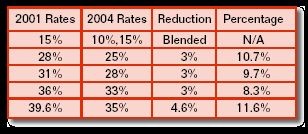Recent tax law changes and proposed IRS regulations promise to make charitable remainder trusts more attractive to existing and potential donors.

The 2003 Tax Act accelerated the future income tax rates scheduled in the 2001 Tax Act. The cumulative effect of these cuts is around a 10% reduction in the marginal federal income tax rates that are effective today.
Under previous law, if a charitable remainder trust had distributed $25,000 of ordinary income, an individual in the top bracket would have owed $9,900 in federal income taxes. The beneficiary would have netted just $15,100 after taxes. Under the new rates, the tax liability would be reduced to $8,750 and the beneficiary would net $16,250 after taxes. The $1,150 difference represents almost another $100 per month in disposable income.
Impact on capital gains
The 2003 Tax Act also lowered most capital gains tax from 20% to 15% effective May 6, 2003. The new general maximum capital gains rate applies to assets like stocks, bonds, and most real estate. A 28% maximum capital gains tax rate still applies to collectibles like coins, art, antiques, or rare automobiles. A 25% rate exists for section 1250 recaptured gain on real estate. The new 15% rate is 25% lower than the old 20% rate. The new 15% rate is also applied to qualified stock dividends.
Consider the impact of these changes on the previous example. If the $25,000 trust distributions were categorized as capital gains and qualified dividends, the tax liability would be further reduced and the beneficiaries’ spendable income further increased. $25,000 reported in this fashion would generate a tax liability of just $3,750. The income recipient would be left with $21,250 after taxes. The income tax liability would be cut by more than half!
Newly proposed IRS regulations make further adjustments to the four-tier payout system to provide guidance on how charitable trust distributions are taxed. Even though the system generally retains its “worst out first” approach, this guidance is welcomed because it will help with tax reporting (see “Planning Matters” in the February 2004 issue of Give & Take).
These changes should benefit both existing and new charitable trusts and gift annuities. Donors with existing unitrusts may even wish to consider additional contributions to them now that the stock market may be on a renewed upward swing. Potential benefits include current income tax deductions, locking in capital gains, no new drafting fees, more spendable income, and a tax-free investment environment within the trust. New trusts may be particularly attractive to donors wishing to diversify their investment on a tax-free basis, increase the cash flow from assets, save on income taxes, lock in gains, and provide for their favorite charities.

